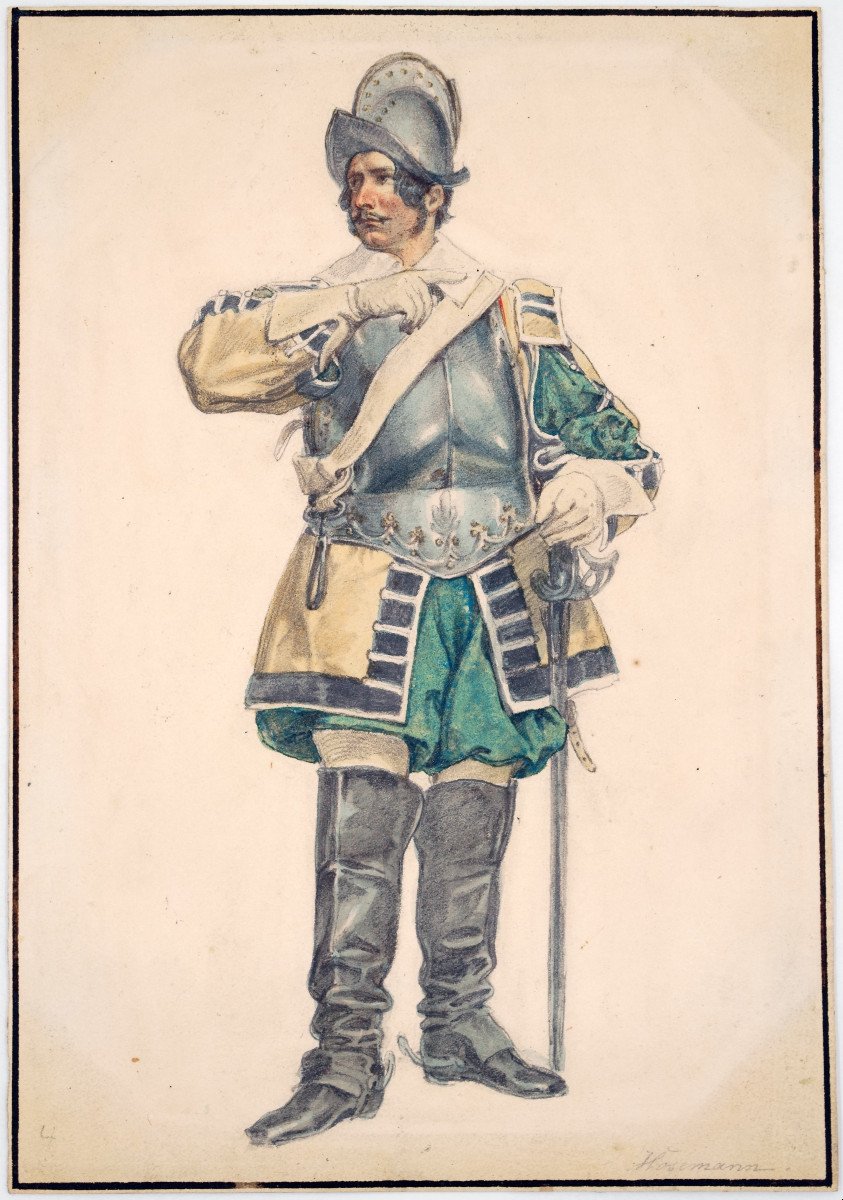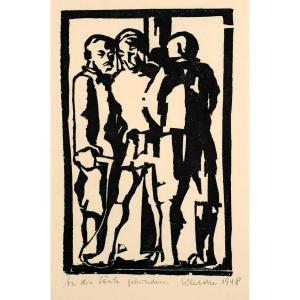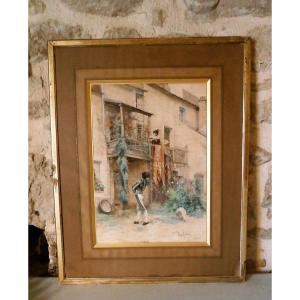- Paper somewhat darkened, dusty and with slight creases, mounting remnants on the reverse. The image itself in vibrant colors and good condition.
- Theatrical Realism -
The drawing is illustrated in the series "Kunst und Künstler" published by Bruno Cassirer in 1925 (vol. XXIII, no. 2, p. 49), where it is identified as a portrait of the actor Karl Seydelmann, probably playing Max Piccolomini from Friedrich Schiller's "Wallenstein". Parallel to Hosemann's realistic art, Seydelmann's expressive performances had helped the art of realistic acting to its breakthrough in Germany. From 1838 until his untimely death in 1843, Seydelmann was employed as a court actor in Berlin.
Hosemann shows the actor portraying Max Piccolomini wearing a balaclava and armor. Standing in contrapposto, leaning on his sword, Max Piccolomini appears as a powerful figure who is not at peace with himself, but remains in place because of a fateful decision to be made. His inner turmoil is expressed by the opposing directions of his gaze and his hand, illustrating the question ultimately directed at himself: "Should I really do this? The inner dilemma is made particularly vivid by the fact that the gestures do not get out of hand in baroque theatricality, but are kept in simple everydayness. This reveals the "new realism" that unites Seydelmann's play with Hosemann's art. The mastery of Hosemann's expressive realism is concentrated in the 'speaking' physiognomy.
About the artist
Theodor Hosemann worked for the "Lithografische Anstalt Arnz & Winckelmann" in Düsseldorf from 1819 until he was twelve years old. From 1822 to 1828 he also studied at the Düsseldorf Academy of Art, where he was a pupil of Wilhelm Schadow from 1826. In 1828, Johann Christian Winckelmann separated from his business partners, the brothers Heinrich and Josef Arnz, and opened the publishing house "Winckelmann & Söhne" in Berlin, specializing in picture and children's books. Theodor Hosemann followed Winckelmann to Berlin as an illustrator for the publisher, where he quickly made a name for himself and also worked for George Gropius' "Bunte Hefte" from 1830. From 1834 to 1852 he worked with the sharp-tongued humorist Adolf Glaßbrenner, who published under the name Adolf Brennglas, and created illustrations for his series "Berlin, wie es ist und - trinkt" (Berlin, as it is and - drinks), "Berliner Volksleben" (Berlin People's Life), and "Komischer Volkskalender" (Comic People's Calendar). From 1842 to 1855 Hosemann was a member of the renowned Berlin literary society "Tunnel über der Spree", where he was known as "[William] Hogarth" for his now mainly humorous illustrations. In 1857 Hosemann was appointed professor at the Berlin Academy, where Heinrich Zille was one of his students in 1874.
Theodor Hosemann's oeuvre includes numerous drawings and about 6000 graphic works. He also worked as a painter. His most important book illustrations include the writings of E.T.A. Hoffmann, the fairy tales of Hans-Christian Andersen, and the adventures of Baron Münchhausen.
"Pre-march Berlin found in him its most faithful chronicler and illustrator; and if he had not created more than his pictures of Berlin folk life, his memory could not be extinguished, and anyone who wants to understand the history of our city in those years must also have Hosemann's depictions at hand - the best pictorial chronicle of those years!”
Publications of the Society for the History of Berlin, September 1897
































 Le Magazine de PROANTIC
Le Magazine de PROANTIC TRÉSORS Magazine
TRÉSORS Magazine Rivista Artiquariato
Rivista Artiquariato